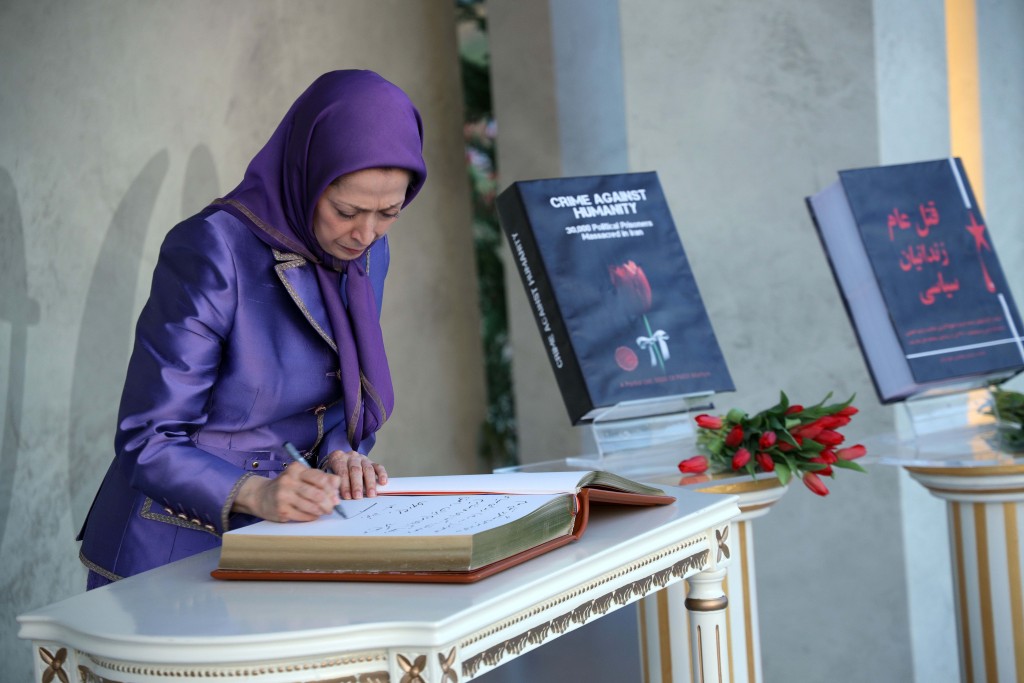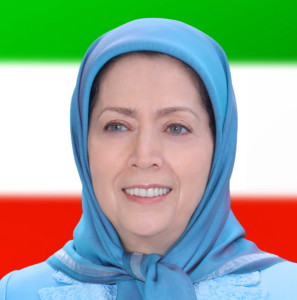Maryam Rajavi’s letter to the United Nations Secretary General on International Human Rights Day regarding the violent suppression of the nationwide uprising in Iran

Mr. Secretary-General,
As the world celebrates the 74th anniversary of the United Nations’ adoption of the Universal Declaration of Human Rights, no part of Iran has remained immune from the brutal and systematic violations of human rights by the ruling religious fascism.
The people of Iran have been taking to the streets against the clerical regime for three months. In response, Khamenei’s band of criminals have transferred to the streets all forms of torture and killing they practiced behind the prison walls over the past four decades.
1. Since September 16, the clerical regime has murdered more than 700 people during street protests. The People’s Mojahedin Organization of Iran (PMOI/MEK) has so far published the names of 580 of these victims.
The regime has carried out mass killings in some cities. On September 30 alone, in Zahedan, Khamenei’s ruthless State Security Force and IRGC opened fire on worshipers, killing dozens. The PMOI has verified and published the names of 111 of them, so far.
The slain protesters include at least 70 children and juveniles aged between two to 17, such as Seyyed Mehdi Mousavi, 15 from Zanjan; Ali Barahui, 14, from Zahedan; Mohammad Reza Sarvi, 13, from Shahr-e Rey; Jaber Sharuzehi, 12, from Zahedan; Mohammad Reza Sarvari, 14, from Tehran; Hasti Narouii, 7, from Zahedan; Mirshekar, 2, from Zahedan; Mona Naghib, 8, from Saravan; Diana Mahmoudi, 7, from Piranshahr; Helen Ahmadi, 7, from Bukan; Kian Pirfalak, 9, from Izeh; Artin Rahmani, 13, from Izeh; and Parmis Hamnava, 14, a high school student in Iranshahr beaten to death.
In addition, hundreds of teenagers under 18 have been arrested, some of whom face death sentences.
Iran protesters describe the ruling regime as a child-killing regime. This has been the characteristic of the clerical regime since the early years of its rule. In 1981, quite a few teenagers who supported the PMOI or young children of PMOI members, such as Fatemeh Mesbah, 13, Mojgan Jamshidi, 14, and Niloufar Tashayyod, 15, were executed on Khomeini’s orders.
2. In the meantime, prisoners have been subjected to attacks by Khamenei’s criminal thugs. On October 9, they attacked the prisoners in Lakan Prison in Rasht. At least 10 prisoners were killed, and more were injured. But the big crime took place in Evin Prison. On October 15, in a premeditated attack, prison guards unleashed dogs inside the wards to attack the prisoners. NOPO (the Farsi acronym for Nirouy-e vijeh Peyroy-e Velayat or Special Force Subservient to Khamenei) attacked wards 4, 7, and 8. They threw some of the inmates off the roof. Snipers targeted the prisoners from the rooftops and shot them with live ammunition or pellet guns. As a result, at least 40 prisoners were killed.
3. The suppressive forces have blinded hundreds of people. They shoot them from close range directly in the eye using pellet guns and rubber bullets. Ophthalmologists in three major hospitals in Tehran, including Farabi, Rasul Akram and Labafinejad, estimate that by the end of the second month of the uprising, they had admitted a total of more than 500 patients who suffered severe eye injuries. Doctors in Kurdistan province estimate that they have admitted at least 80 people whose eyes were injured during this period. Over 230 Iranian ophthalmologists signed a letter addressed to the head of the Ophthalmology Association, warning about the “irreparable consequences of such severe injuries.”
4. In less than three months, the suppressive forces, especially the IRGC and the Ministry of Intelligence, have arrested more than 30,000 people. The regime officials have admitted that they lack enough space to detain so many prisoners.
One of the regime’s common practices is kidnapping young people, killing them, and dumping their bodies. Mehrshad Talatof, a 22-year-old resident of Iranshahr, disappeared after Friday prayers and his body was found on a road a few days later.
Atefeh Na’ami, a 37-year-old woman from Ahvaz, was missing for eight days before her lifeless body was found.
In some cities, regime forces attack people’s homes late at night or early morning, shooting to intimidate, beating the defenseless residents, and arresting them.
5. Inhuman tortures are rampant in prisons:
In Mashhad, torturers beat Amir Javad As’adzadeh, 30, all night long until morning until he died.
Mehdi Kaboli Kafshgiri, 15, was arrested in Gorgan. Due to heavy blows, he fell into a coma and died in the hospital.
Others who died under torture include Ovais Masoudizadeh from Torbat-e Jam; Emad Heydari, 31, from Ahvaz; Mohammad Abdollahi from Ilam; Mehdi Farhani, 17, from Khorramshahr; Mohammad Lotfollahi from Sanandaj; Hamed Salahshoor, 25, from Izeh; Yazdan Aghajani, 38, from Tehran; Hassan Nasserikhor from Mashhad; Neda Bayat from Zanjan, Heyman Aman, 26, from Bukan; Mansour Ghorbani from Isfahan; Mostafa Moghaddam from Izeh, Saman Qaderpour, 37, from Oshnavieh; Navid Badpa from Gonbad Kavous; Morteza Soltanian from Isfahan; Ali Bani Assad, 20, from Ahvaz; Ramin Fatehi from Sanandaj; and Omid Hassani from Sanandaj.
6. Some severely tortured prisoners died a few days after being released from prison.
Farshid Moussavi, 24, had been detained in Amol for 25 days. He lost his life after being released from prison.
Arshia Emamgholizadeh, 18, from Hadishahr, committed suicide two days after being released.
Yalda Aghafazli, 19, from Tehran, was arrested on October 26 and released on November 6. She committed suicide due to excruciating torture in prison.
Reza Sharafi, 35, from Sisakht, died abruptly after being released.
7. According to the testimony of many eyewitnesses and those who survived the regime’s prisons in the last couple of months, rape and sexual assault on male and female prisoners has been one of the systematic methods of torturing prisoners. CNN published a report about this on November 21, recounting some of these crimes.
8. Since the beginning of this uprising, the regime has tried to make up other causes for the deaths of those killed in the streets by repressive forces or under torture in the prisons.
They claimed that Mahsa Amini had died due to pre-existing medical conditions.
In the case of Abolfazl Adinezadeh, 17, in Mashhad, they claimed that he was a member of the paramilitary Bassij and was killed by the rioters.
They claimed that Farzin Farrokhi had died because of drinking alcoholic beverages.
In the case of Pouria Kiani from Izeh, they claimed he had committed suicide over a love affair.
They have put pressure on the family of Nahid Mostafapour in Yasuj, to say that she had died of coronavirus.
They claimed that Marzieh Doshman Ziari, 22, had been killed in a car accident in Bushehr.
They claimed that Farzaneh Kazemi from Qazvin had been killed by her husband.
They said Ali Fazeli was a Bassij member and killed by the rioters.
The regime announced suicide as the cause of death of Sina Firouzabadi.
Darya Nazmdeh from Karaj was murdered on November 8. The regime claimed she had died in a car accident.
As for Samaneh Niknam, 36, the regime officials claimed she had died of miscarriage.
Hassan Nasseri Khor died under torture, but the regime claimed he had suffered cardiac arrest.
Regarding the killing of inmates in Lakan Prison of Rasht, the prosecutor of Gilan claimed, “The prisoners had refused medical services, and as a result, some of those injured died.”
9. Another aspect of the appalling behavior of Khamenei’s mercenaries in confronting the Iranian people’s uprising has been snatching the bodies of murdered protesters from morgues and burying them secretly, preventing the grieving families from holding funerals for their loved ones, and destroying the graves of slain protesters. The latter has been one of the regime’s most notorious practices over the past four decades, that included desecrating the graves of martyred members and supporters of the PMOI throughout Iran.
10. The latest heinous crime of the clerical regime was the execution of the 23-year-old Mohsen Shekari about which you are aware. This act of vengeance by the regime was to counter the people’s uprising. According to the prosecutor’s statement, the reason for his execution was blocking a street and injuring a Bassij member in the hand, none of which are punishable with death, even according to the regime’s laws.
11. The ruling religious dictatorship has been openly killing people and shedding blood before the eyes of the people of the world for the past three months. But the United Nations and its member states have not taken any concrete measures to stop the regime’s crimes.
The regime’s officials, and specifically Ali Khamenei, his president Ebrahim Raisi, the Judiciary Chief, Gholam-Hossein Mohseni Eje’i, and the speaker of the Parliament, Mohammad Bagher Ghalibaf, have been involved in crimes against humanity and genocide over the past four decades. The executions of the 1980s, the massacre of the people of Kurdistan, the massacre of political prisoners in 1988, the killing of at least 1,500 protesters in November 2019, the killing of the passengers of the Ukrainian airlines flight 752 in January 2020 by the IRGC, and the killing and torture of protesters arrested during the recent uprising, are all parts of their record.
Why does the United Nations not bar the regime’s representatives from entering the General Assembly, as it did in the 1970s when the representative of South Africa’s Apartheid regime was banned?
Why the World Bank and the International Monetary Fund, which stopped all their programs in Belarus, do not apply such a policy to the regime?
Why does the United Nations not revoke the regime’s membership in UNICEF considering that so many innocent children have been killed by the IRGC’s direct fire?
The Iranian Resistance is fighting for the establishment of freedom, equality, and democracy in Iran and for a republic based on the separation of religion and state. It has pledged to restore human rights in Iran, gender equality, autonomy of the oppressed ethnic minorities and abolish the death penalty, after the overthrow of the religious dictatorship.
The NCRI has vowed to fully adhere to the Universal Declaration of Human Rights, the International Covenant on Civil and Political Rights, the Convention Against Torture and the Convention on the Elimination of All Forms of Discrimination Against Women.
It is committed to the establishment of a modern judicial system, based on respect for the principle of presumption of innocence, the right to defense, the right to litigation, emphasizing the right to a public trial and the full independence of judges.
May our people in tomorrow’s Iran enjoy “freedom of speech and belief and freedom from fear and want” and see a world “proclaimed as the highest aspiration of the common people.”
Mr. Secretary General,
Under these circumstances, the Iranian people expect the United Nations and governments around the world to:
– Shut down the regime’s embassies which provide political and logistic support to the repressive operations inside Iran and stop their dealing with the regime.
– Designate the Ministry of Intelligence and the Revolutionary Guard Corps, the main entities behind the killings and repression, as terrorist entities, and to expel their agents and operatives.
– Recognize the legitimacy of the Iranian people’s struggle to overthrow the religious dictatorship. The Universal Declaration of Human Rights has endorsed “rebellion against tyranny and oppression,” “as a last resort” when human rights are not protected by the rule of law. And this is what the courageous youths and Resistance Units in Iran are determined to carry out.
- Tags: execution, Human Rights, mullahs' regime, Uprising

